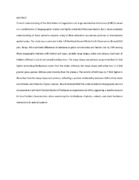| dc.description.abstract | Current understanding of the distribution of vegetation and large mammalian herbivores (LMH) is based
on a combination of biogeographic studies and highly controlled field experiments, but a more complete
understanding of these patterns requires study of their natural co-occurrence patterns at intermediate
spatial scales. The study was conducted in the 120-ha Mpala Forest Global Earth Observatory (ForestGEO)
plot, Kenya. We examined differences in herbaceous plant communities and habitat use by LMH among
three topographic habitats with distinct soil types, namely steep slopes, valley and plateau. Each pair of
habitats differed in plant and animal com position. The steep slopes and plateau respectively had ≥1-fold
higher percentage herbaceous cover than the valley, whereas the steep slopes and valley had >1.5-fold
greater grass species richness and diversity than the plateau. The activity of LMH was ≥1.7-fold higher in
the valley than the steep slopes and plateau, reflecting a positive relationship between LMH activity index
and richness and diversity of grass species. Results indicate that fine-scale variation in topography and soil
are associated with both the distribution of herbaceous vegetation and LMH, suggesting a need to account
for local habitat characteristics when examining the distributions of plants, animals, and plant-herbivore
interactions in natural systems | en_US |
